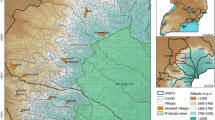Abstract
Indigenous knowledge has influenced native species selection in agroforestry systems worldwide. However, scientific advancements in plant sciences, agroforestry technologies and trade have accelerated species movements and establishment beyond their native range. Managing native and non-native species is an important area of research in agroforestry and this thematic issue includes 13 papers that cover a range of topics from the role of non-native species in agroforestry to management interventions to improve yield. As evident from these papers, non-native plants are still an important component of agroforestry in many parts of the world. Whether native or non-native, management interventions can increase the economic, environmental and social values of these species and that of agroforestry. Collectively, these papers attest to the increasing body of foundational knowledge in agroforestry.

Similar content being viewed by others
References
Cannell MGR, van Noordwijk M, Ong CK (1996) The central agroforestry hypothesis: the trees must acquire resources that the crop would not otherwise acquire. Agrofor Syst 34:27–31
D’Antonio C, Meyerson LA (2002) Exotic plant species as problems and solutions in ecological restoration: a synthesis. Rest Ecol 10:703–713
Holzmueller EJ, Jose S (2011) Invasion success of cogongrass, an alien C4 perennial grass, in the southeastern United States: Exploration of the ecological basis. Biol Invasions 13:435–442
Jose S (2009) Agroforestry for ecosystem services and environmental benefits: an overview. Agrofor Syst 76:1–10
Jose S, Gillespie AR, Seifert JR, Biehle DJ (2000) Defining competition vectors in a temperate alleycropping system in the midwestern USA: II. Compet water Agrofor Syst 48:41–59
Jose S, Gillespie AR, Pallardy SG (2004) Interspecific interactions in temperate agroforestry. Agrofor Syst 61:237–255
Kohli R, Jose S, Batish D, Singh H (2008) Invasive plants and forest ecosystems. CRC/Taylor and Francis, Boca Raton
Pimentel D (2005) Ecological consequences and economic costs of alien species. In: Inderjit S (ed) Invasive plants: ecological and agricultural aspects. Birkhauser-Verlag AG, Basel
Wanvestraut R, Jose S, Nair PKR, Brecke BJ (2004) Competition for water in a pecan-cotton alley cropping system in the southern United States. Agrofor Syst 60:167–179
Wilcove DS, Rothstein D, Bubow J, Phillips A, Losos E (1998) Quantifying threats to imperiled species in the United States. Bioscience 48:607–615
Zamora D, Jose S, Napolitano K (2009) Competition for 15N labeled nitrogen in a loblolly pine-cotton alley cropping system in the southern United States. Agric Ecosyst Environ 131:40–50
Author information
Authors and Affiliations
Corresponding author
Rights and permissions
About this article
Cite this article
Jose, S. Managing native and non-native plants in agroforestry systems. Agroforest Syst 83, 101–105 (2011). https://doi.org/10.1007/s10457-011-9440-1
Published:
Issue Date:
DOI: https://doi.org/10.1007/s10457-011-9440-1




